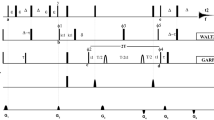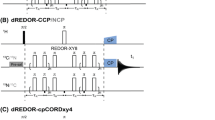Abstract
Here, we report novel methods to measure rate constants for homodimer subunit exchange using double electron–electron resonance (DEER) electron paramagnetic resonance spectroscopy measurements and nuclear magnetic resonance spectroscopy based paramagnetic relaxation enhancement (PRE) measurements. The techniques were demonstrated using the homodimeric protein Dsy0195 from the strictly anaerobic bacterium Desulfitobacterium hafniense Y51. At specific times following mixing site-specific MTSL-labeled Dsy0195 with uniformly 15N-labeled Dsy0195, the extent of exchange was determined either by monitoring the decrease of MTSL-labeled homodimer from the decay of the DEER modulation depth or by quantifying the increase of MTSL-labeled/15N-labeled heterodimer using PREs. Repeated measurements at several time points following mixing enabled determination of the homodimer subunit dissociation rate constant, k −1, which was 0.037 ± 0.005 min−1 derived from DEER experiments with a corresponding half-life time of 18.7 min. These numbers agreed with independent measurements obtained from PRE experiments. These methods can be broadly applied to protein–protein and protein-DNA complex studies.






Similar content being viewed by others
References
Aquilina JA, Benesch JLP, Ding LL, Yaron O et al (2005) Subunit exchange of polydisperse proteins. J Biol Chem 280:14485–14491
Battiste JL, Wagner G (2000) Utilization of site-directed spin labeling and high-resolution heteronuclear nuclear magnetic resonance for global fold determination of large proteins with limited nuclear overhauser effect data. Biochemistry 39:5355–5365
Borbat PP, McHaourab HS, Freed JH (2002) Protein structure determination using long-distance constraints from double-quantum coherence ESR: study of T4 lysozyme. J Am Chem Soc 124:5304–5314
Bova MP, Ding L–L, Horwitz J, Fung BK-K (1997) Subunit Exchange of αA-crystallin. J Biol Chem 272:29511–29517
Bova MP, Mchaourab HS, Han Y, Fung BK-K (2000) Subunit exchange of small heat shock proteins. J Biol Chem 275:1035–1042
Cai SJ, Inouye M (2003) Spontaneous subunit exchange and biochemical evidence for trans-autophosphorylation in a dimer of E. coli histidine kinase (EnvZ). J Mol Biol 329:495–503
Clore GM, Tang C, Iwahara J (2007) Elucidating transient macromolecular interactions using paramagnetic relaxation enhancement. Curr Opin Struct Biol 17:603–616
Cooper T, Leifert WR, Glatz RV, McMurchie EJ (2008) Expression and characterisation of functional lanthanide-binding tags fused to a G-protein and muscarinic (M2) receptor. J Bionanosci 2:27–34
Darke PL, Jordan SP, Hall DL, Zugay JA et al (1994) Dissociation and association of the HIV-1 protease dimer subunits: equilibria and rates. Biochemistry 33:98–105
Folmer RH, Hilbers CW, Konings RN, Hallenga K (1995) A (13)C double-filtered NOESY with strongly reduced artefacts and improved sensitivity. J Biomol NMR 5:427–432
Gabdoulline RR, Wade RC (2002) Biomolecular diffusional association. Curr Opinion Struct Biol 12:204–213
Gavin AC, Aloy P, Grandi P, Krause R et al (2006) Proteome survey reveals modularity of the yeast cell machinery. Nature 440:631–636
Ghimire H, McCarrick RM, Budil DE, Lorigan GA (2009) Significantly improved sensitivity of Q-band PELDOR/DEER experiments relative to X-band is observed in measuring the intercoil distance of a leucine zipper motif peptide (GCN4-LZ). Biochemistry 48:5782–5784
Goodsell DS, Olsen AJ (2000) Structural symmetry and protein function. Annu Rev Biophys Biomol Struct 29:105–153
Hilger D, Polyhach Y, Padan E, Jung H et al (2007) High-resolution structure of a Na+/H+ antiporter dimer obtained by pulsed electron paramagnetic resonance distance measurements. Biophys J 93:3675–3683
Iwahara J, Clore GM (2006) Detecting transient intermediates in macromolecular binding by paramagnetic NMR. Nature 440:1227–1230
Jeschke G, Abbott RJM, Lea SM, Timmel CR et al (2006a) The characterization of weak protein–protein interactions: evidence from DEER for the trimerization of a von Willebrand factor A domain in solution. Angew Chem Int Ed 45:1058–1061
Jeschke G, Chechik V, Ionita P, Godt A et al (2006b) DeerAnalysis2006—a comprehensive software package for analyzing pulsed ELDOR data. Appl Magn Reson 30:473–498
Lee W, Revington MJ, Arrowsmith C, Kay LE (1994) A pulsed field gradient isotope-filtered 3D 13C HMQC-NOESY experiment for extracting intermolecular NOE contacts in molecular complexes. FEBS Lett 350:87–90
Levy ED, Boeri Erba E, Robinson CV, Teichmann SA (2008) Assembly reflects evolution of protein complexes. Nature 453:1262–1265
Liang JJ, Liu B-F (2006) Fluorescence resonance energy transfer study of subunit exchange in human lens crystallins and congenital cataract crystallin mutants. Protein Sci 15:1619–1627
Mathhews JM, Sunde M (2012) Dimers, oligomers, everywhere. Adv Exp Med Biol 747:1–18
Nooren IM, Thornton JM (2003) Structural characterisation and functional significance of transient protein–protein interactions. J Mol Biol 325:991–1018
Otting G, Wüthrich K (1989) Extended heteronuclear editing of 2D 1H NMR spectra of isotope-labeled proteins, using the X(ω1, ω2) double half filter. J Magn Reson 85:586–594
Pannier M, Veit S, Godt A, Jeschke G et al (2000) Dead-time free measurement of dipole–dipole interactions between electron spins. J Magn Reson 142:331–340
Pervushin K, Riek R, Wider G, Wüthrich K (1997) Attenuated T 2 relaxation by mutual cancellation of dipole–dipole coupling and chemical shift anisotropy indicates an avenue to NMR structures of very large biological macromolecules in solution. Proc Natl Acad Sci USA 94:12366–12371
Polyhach Y, Bordignon E, Tschaggelar R, Gandra S et al (2012) High sensitivity and versatility of the DEER experiment on nitroxide radical pairs at Q-band frequencies. Phys Chem Chem Phys 14:10762–10773
Rumpel S, Becker S, Zweckstetter M (2008) High-resolution structure determination of the CylR2 homodimer using paramagnetic relaxation enhancement and structure-based prediction of molecular alignment. J Biomol NMR 40:1–13
Schanda P, Brutscher B (2005) Very fast two-dimensional NMR spectroscopy for real-time investigation of dynamic events in proteins on the time scale of seconds. J Am Chem Soc 127:8014–8015
Scholosshauer M, Baker D (2004) Realistic protein–protein association rates from a simple diffusional model neglecting long-range interactions, free energy barriers, and landscape ruggedness. Protein Sci 13:1660–1669
Shen HB, Chou KC (2009) Quatldent: a web server for identifying protein quaternary structural attribute by fusing functional domain and sequential evolution information. J Proteome Res 8:1577–1584
Smoluchowski MV (1917) Versuch einer mathematischen theorie der koagulationskinetik kolloider loeschungen. Z Phys Chem 92:129–168
Sobott F, Benesch JLP, Vierling E, Robinson CV (2002) Subunit exchange of multimeric protein complexes. J Biol Chem 277:38921–38929
Tang C, Iwahara J, Clore GM (2006) Visualization of transient encounter complexes in protein–protein association. Nature 444:383–386
Tang C, Schwieters CD, Clore GM (2007) Open-to-closed transition in apo maltose-binding protein observed by paramagnetic NMR. Nature 449:1078–1082
Tang C, Ghirlando R, Clore GM (2008a) Visualization of transient ultra-weak protein self-association in solution using paramagnetic relaxation enhancement. J Am Chem Soc 130:4048–4056
Tang C, Louis JM, Aniana A, Suh JY et al (2008b) Visualizing transient events in amino-terminal autoprocessing of HIV-1 protease. Nature 455:693–696
Uetrecht C, Watts NR, Stahl SJ, Wingfield PT et al (2010) Subunit exchange rates in Hepatitis B virus capsids are geometry- and temperature-dependent. Phys Chem Chem Phys 12:13368–13371
Vinogradova O, Qin J (2012) NMR as a unique tool in assessment and complex determination of weak protein–protein interactions. Top Curr Chem 326:35–45
Ward R, Bowman A, El-Mkami H, Owen-Hughes T et al (2009) Long distance PELDOR measurements on the histone core particle. J Am Chem Soc 131:1348–1349
Yagi H, Banerjee D, Graham B, Huber T, Goldfarb D et al (2011) Gadolinium tagging for high-precision measurements of 6 nm distances in protein assemblies by EPR. J Am Chem Soc 133:10418–10421
Yang Y, Ramelot TA, McCarrick RM, Ni S et al (2010) Combining NMR and EPR methods for homodimer protein structure determination. J Am Chem Soc 132:11910–11913
Yang Y, Ramelot TA, Cort JR, Wang H et al (2011) Solution NMR structure of Dsy0195 homodimer from Desulfitobacterium hafniense: first structure representative of the YabP domain family of proteins involved in spore coat assembly. J Struct Funct Genomics 12:175–179
Yu D, Volkov AN, Tang C (2009) Characterizing dynamic protein–protein interactions using differentially scaled paramagnetic relaxation enhancement. J Am Chem Soc 131:17291–17297
Acknowledgments
This work was supported by the National Institute of General Medical Sciences; Protein Structure Initiative-Biology Program; Grant Number U54-GM094597. The majority of the data collection was conducted at the Ohio Center of Excellence in Biomedicine in Structural Biology and Metabonomics at Miami University. We acknowledge Gaetano Montelione, John Everett, and the rest of the Protein Production group at Rutgers University for providing the Dsy0195 mutants used in this study.
Author information
Authors and Affiliations
Corresponding author
Rights and permissions
About this article
Cite this article
Yang, Y., Ramelot, T.A., Ni, S. et al. Measurement of rate constants for homodimer subunit exchange using double electron–electron resonance and paramagnetic relaxation enhancements. J Biomol NMR 55, 47–58 (2013). https://doi.org/10.1007/s10858-012-9685-7
Received:
Accepted:
Published:
Issue Date:
DOI: https://doi.org/10.1007/s10858-012-9685-7




